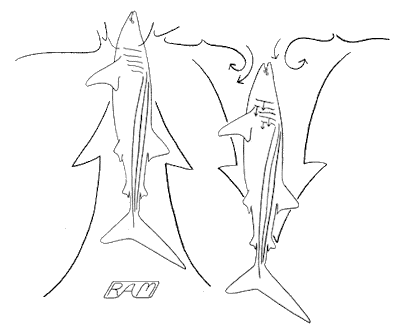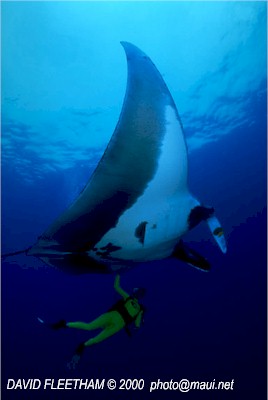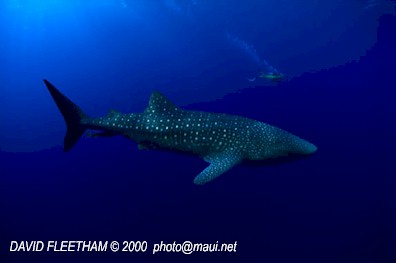Building a Better Mouth Trap
By now we've all seen them: those awesome, slow-motion images of White Sharks being fed at the surface. The gaping jaws of the Great White Shark have become a potent image of the modern world. Celluloid has popularized and magnified the image of the Great White, which has come to epitomize the ultimate in predation and the archetype of sharkdom. But this popular conception does not do justice to the diversity of sharks and their 'pancake' cousins, the skates, rays, sawfishes, and guitarsharks. Collectively termed elasmobranchs (meaning 'strap-gills'), these cartilaginous fishes are a highly varied group of marine vertebrates, encompassing an amazing range of forms and lifestyles.
Fossil evidence suggests that elasmobranchs have been primarily predatory from their earliest beginnings and throughout their long evolutionary career, from the Middle Paleozoic some 425 million years ago to the present. Over that enormous timespan they have undergone several major adaptive radiations — including some truly bizarre tinkering with shark design — and survived at least eight mass extinctions that many other types of creature did not. The most recent elasmobranch radiation coincided with the mammalian radiation that eventually produced ourselves. Modern elasmobranchs are thus the distillation of millions of years of experiments on how to build a predator. They are a fundamental life form, united by numerous elegant and highly evolved structural, physiological, and behavioral features. While undeniably ancient, there is nothing 'primitive' about today's sharks and rays.
The vast majority of living sharks and rays are predatory. Of some 1,100 species of extant elasmobranchs, only 13 (1.2%) — the Basking Shark (Cetorhinus maximus), Megamouth Shark (Megachasma pelagios), Whale Shark (Rhincodon typus), Manta Ray (Manta birostris) and about 9 species of Devil Rays (genus Mobula) — have forsaken the actively predacious habits of their kin and adapted to a more placid 'grazing' lifestyle. These thirteen species of filter-feeding elasmobranch are not particularly closely related, representing four separate evolutionary lineages. What makes the shift to filter-feeding particularly intriguing is that all four lineages undertook the shift at about the same time, between 60 and 30 million years ago in the Cenozoic Era. Thirty million years may seem an awfully long time in terms of a mortgage, but it represents only 7% of the total period elasmobranchs have existed. What environmental pressures precipitated this profound dietary shift? How have these animals been modified for a filter-feeding mode of life? And, given the groups' enormous long-term success as predators, why have they done so?
|
Photo © David Fleetham david@davidfleetham.com; used with the gracious permission of the photographer. |
Elasmobranch filter-feeding mechanisms can be conveniently divided into two categories: 1) modified gill rakers and, 2) spongy elaboration of the gill bars. Filters of the first category are relatively coarse, being composed of modified dermal denticles (placoid scales), and are found in two cold-water species, the temperate Basking Shark and the deep-sea Megamouth Shark. The gill rakers of the Basking Shark are bristle-like, some 3 inches (7.5 centimetres) long in an average 30-foot (9-metre) specimen and number about 10 per inch (4 per centimetre) of gill bar. In contrast, the gill rakers of Megamouth are papillose ('finger like') with a spongy cartilaginous core, arranged in four rows along each gill bar and about 4 to 6 inches (10 to 15 centimetres) long in a 15-foot (4.5-metre) specimen. Filters of the second category are finer, composed of pinkish-brown spongy tissue arranged in flattened, horizontal plates that bridge the 'gaps' between successive gill bars. This category of filter is found in the Whale Shark and the Manta and Devil Rays, which inhabit primarily tropical to warm-temperate seas with relatively thin plankton biomass. The Basking Shark, Megamouth, Whale Shark, Manta and Devil Rays each has different accessory feeding structures, which are correlated with differing feeding behaviors.
The Basking Shark is a passive filter-feeder, relying on ram-jet ventilation to force plankton-bearing water through its pharynx and out the gills. The Basking Sharks' diet consists almost entirely of a single genus of copepod (Calanus), with a smattering of fish eggs and arrow-worms; this prey specificity suggests that the gill raker filtration system of the Basking Shark may not be as simple as it appears. About 1,500 tons (1,360 tonnes) of water an hour pass through a Basking Shark's gigantic gill slits; periodically (every two to three minutes or so), a feeding Basking Shark flutters its gills sharply, possibly to swallow accumulated planktonic food trapped by the gill rakers. During spring and summer, the planktonic prey of the Basking Shark is abundant, but even under the most favorable conditions, this shark must work hard to make a living. It has been calculated that a 22-foot (6.7 metre) Basking Shark requires about 663 calories per hour just to propel its massive body through the water; when plankton supply falls off during early winter, the Basking Shark can typically consume only 2 pounds of copepods — about 410 calories — an hour. So in winter, a Basking Shark would be using up more energy in swimming than it could get from its food. Since numerous Basking Sharks have been captured in winter without their gill rakers, it has been suggested that when plankton concentrations fall below sustenance levels the Basking Shark sheds its gill rakers and switches to bottom feeding or hibernates until plankton concentration increases again in the spring. If this is true, the seasonal shedding of gill rakers by the Basking Shark would be the only known instance of an annual moult in fishes.
Because most plankton is found near the surface, the mesopelagic Megamouth Shark faces some serious challenges in acquiring enough to eat. Due to its nutrient-poor deep-sea habitat, Megamouth has mushy muscles and a poorly calcified skeleton, making it a rather weak swimmer. The huge, bathtub-sized jaws and supporting arches are highly mobile, suggesting that Megamouth feeds by expanding its pharynx and sucking prey into its mouth. This pharyngeal vacuum may be enhanced by simultaneously raising the huge and highly mobile basihyal ('tongue'). In addition, Megamouth has two sheets of guanine-silvered tissue hanging inside the upper jaw. It has been speculated that Megamouth may be bioluminescent, relying on light to lure its prey (deep-sea shrimp and jellyfishes) within range of its extensible jaws. If true, this deep-sea shark may be the world's largest bioluminescent organism. First captured off Oahu, Hawaii in November 1976, Megamouth has been hailed as the most astounding ichthyological discovery since the 1938 capture of a live coelacanth off East London, South Africa. To date, only 14 specimens of Megamouth are known (from Hawaii, California, Japan, Western Australia, Brazil, Senegal, Indonesia, Philippines). All of this was pretty much academic until October 1990, when a Megamouth Shark made international news. A 16-foot specimen was captured live in a driftnet off Dana Point, California, fitted with two sonic tags, released and tracked for two days. This individual Megamouth Shark remained at a depth of about 50 feet (15 metres) during the night then dived to 490 feet (150 metres) at dawn. Thus, like many other deep-sea creatures, Megamouth is a vertical migrator — following its planktonic prey toward the surface at night and back into deeper water before dawn. In other words, Megamouth is a commuter!
 Growing to a length of at least 50
feet (15 metres), the Whale Shark is the largest fish
on our planet. Unlike the weakly-muscled Megamouth, the Whale Shark has powerful
swimming, throat, and gill pouch musculature. The bellows-like gill pouches make
the Whale shark a versatile filter-feeder, enabling it to consume a wide variety
of planktonic crustaceans and even small to mid-sized fishes such as sardines,
anchovies, and mackerels. Because of its ability to suck food into its mouth,
the Whale Shark is not dependent upon forward motion to operate its filters and
often assumes a vertical posture when feeding. It has been reported that Whale
Sharks enhance the efficiency of vertical feeding by 'bobbing' up and down in 15
to 20-second cycles, pausing at the surface to allow food-bearing water to rush
into their mouths and strain through their spongy gill plates; this behavior has
been recently filmed by the Cousteau Society off Cuba. There are numerous
reports of associations between Whale Sharks and schooling pelagic fishes,
particularly skipjack and albacore. These large fishes may be feeding on smaller
fishes congregating to feed on the same plankton concentrations as the Whale
Sharks. Stewart Springer reported that he once saw several tuna appear to leap
into the mouth of a vertically-feeding Whale Shark at the completion of each
'bobbing' cycle. If Whale Sharks actually swallow the large fishes they suck in
(accidentally or otherwise), they must add considerably to the Sharks' protein
intake!
Growing to a length of at least 50
feet (15 metres), the Whale Shark is the largest fish
on our planet. Unlike the weakly-muscled Megamouth, the Whale Shark has powerful
swimming, throat, and gill pouch musculature. The bellows-like gill pouches make
the Whale shark a versatile filter-feeder, enabling it to consume a wide variety
of planktonic crustaceans and even small to mid-sized fishes such as sardines,
anchovies, and mackerels. Because of its ability to suck food into its mouth,
the Whale Shark is not dependent upon forward motion to operate its filters and
often assumes a vertical posture when feeding. It has been reported that Whale
Sharks enhance the efficiency of vertical feeding by 'bobbing' up and down in 15
to 20-second cycles, pausing at the surface to allow food-bearing water to rush
into their mouths and strain through their spongy gill plates; this behavior has
been recently filmed by the Cousteau Society off Cuba. There are numerous
reports of associations between Whale Sharks and schooling pelagic fishes,
particularly skipjack and albacore. These large fishes may be feeding on smaller
fishes congregating to feed on the same plankton concentrations as the Whale
Sharks. Stewart Springer reported that he once saw several tuna appear to leap
into the mouth of a vertically-feeding Whale Shark at the completion of each
'bobbing' cycle. If Whale Sharks actually swallow the large fishes they suck in
(accidentally or otherwise), they must add considerably to the Sharks' protein
intake!
The exquisitely graceful Manta and Devil Rays rely on ram-jet ventilation to force plankton-bearing water through their ridged gill plates. But unlike the temperate water Basking Shark, these tropical rays have forward extensions of the pectoral wings called 'cephalic fins'; these flexible, horn-like fins may assist Manta and the lesser-known Devil Rays in concentrating plankton and channeling it into their mouths. Their wing-like pectoral fins give these rays extraordinary maneuverability, enabling them to circle and wheel tightly around their planktonic prey. It is possible that such acrobatic behavior may serve to further concentrate plankton and facilitate feeding. When they have finished feeding, Manta Rays can furl the cephalic fins into hydrodynamically-sound 'cutwaters'; I have seen Mantas fold their cephalic fins so that they meet at the midline of the mouth, resembling paddle-shaped 'hands' of a Far Eastern guru reciting mantras ('Mantra Rays'?), then depart rapidly. Unfortunately very little else is known about the feeding behavior of these beautiful rays.
For all their diversity, filter-feeding elasmobranchs share several features in common. Their heads are broad and their mouths have returned to the ancestral terminal position (most modern sharks have 'subterminal' jaws — located on the underside of the head). Teeth are reduced in size and significance — though not necessarily in number: the Whale Shark may have more than 27,000 teeth arranged in some 310 rows. The gill mechanism is elaborated to include sieve-like bristles or spongy filter plates. All filter-feeding elasmobranchs are quite large ... and some are downright gigantic. Large size not only reduces an organism's risk of predation, but also increases swimming efficiency — no small consideration if one's food supply is thinly distributed across entire ocean basins. And last but not least, those filter-feeding elasmobranchs which prey largely on planktonic crustaceans need special enzymes to break-down the chitinous exoskeletons (chitin is a complex heterosaccharide, similar to cellulose, and just as difficult to digest). These are all pretty major modifications. In many ways, these modifications resemble those of the baleen whales — which, by no small coincidence — appeared at about the same time as the filter-feeding elasmobranchs. What environmental conditions might account for such a wholesale shift to filter-feeding?
Sixty million years ago our planet was undergoing some major changes. India and Africa had split away from Gondwanaland, but South America, Antarctica, and Australia retained a land connection. The Atlantic and Southern Indian Ocean widened, while the Pacific diminished. Equatorial energy input from the sun was restricted in ocean basins, rendering oceanic currents rather sluggish. The creation of new seas and reduction in size of older seas disrupted oceanic circling patterns and radically changed the global climate. The general warm and humid conditions typical of Jurassic and early to mid-Cretaceous cooled toward the end of the Cretaceous; the Paleocene continued this trend, but was followed by warming in the Eocene. Mass extinctions, during which many different types of life die out within a relatively short period, occur at roughly 26-million-year cycles. During the Cretaceous Extinction, 15% of marine invertebrate families (about 50% of existing species) died out, including bivalves, gastropods, and cephalopods; many aquatic vertebrates also died out at about this time, including numerous families of bony fishes and marine reptiles. This 'sweeping away' was followed by a 'Post- Cretaceous Explosion' of diversity. Planktonic diatoms underwent major radiations, while copepods, dinoflagellates and coccoliths remained strong. Reef-building corals increased in abundance and diversity, creating more habitats and feeding niches. In response, elasmobranch and especially bony fish diversity flowered.
Although widely regarded as a planktivore, the Whale Shark (Rhincodon typus) is actually a highly versatile feeder, using suction to pump in large fishes as well as filtering plankton and other tiny creatures from the water.
Photo © David Fleetham david@davidfleetham.com; used with the gracious permission of the photographer.
It was under these conditions that the filter-feeding elasmobranchs evolved. Despite the major physical and behavioral modifications required, filter-feeding has much to recommend it. By feeding directly on the lowest and most productive end of the food chain, filter-feeding elasmobranchs and baleen whales are able to circumvent the fundamental energy problem inherent to most food chains. But evolution is conservative, tending to leave functioning designs well enough alone. The chief benefits associated with a dietary shift from predation to filter feeding are: 1) specialization reduces feeding competition and, 2) large size reduces predation risk and 3) large size allows retention of metabolic body heat, allowing functioning in cold water. The chief drawbacks to filter-feeding are: 1) food supply is thinly distributed, requiring much swimming effort to secure sufficient nourishment and, 2) food supply is subject to wide fluctuations in relative abundance, especially in temperate zones. But to persist over 60 million years the benefits must outweigh the costs, and the compromise be well worth it.
Those four elasmobranch lineages which needed the least modification were 'preadapted' to make the big shift from predation to filter-feeding. (Preadaptation is an unfortunate term, suggesting that organisms somehow evolve features in 'anticipation' of benefit under future environmental conditions; in truth, almost the exact opposite occurs: those organisms which have NOT inherited the potential to take advantage of an environmental change are selected against by the environment ... luck of the genetic draw.) The Basking and Megamouth Sharks are lamnoids (related to the Great White and thresher sharks, respectively), a group characterized by short snouts, long gill slits, and large size. The Whale Shark is an orectoloboid (related to the Nurse and Zebra Sharks), a group which features a near-terminal mouth, broad head, and large gills with powerful muscles. The Manta and Devil Rays are mobulids (related to the sting and eagle rays), a group having relatively short snouts, teeth modified into crushing plates, large gills and body size.
So what precipitated the Big Shift from active predation to a more placid 'grazing' lifestyle? Intense competition for nectonic (swimming) prey at the benthos and throughout the water column and/or a high concentration of plankton — at least seasonally — might have favored the shift from active predation to a filter-feeding mode. Perhaps an opportunistic, short-term seasonal dietary shift in the ancestral types became fixed under conditions of reduced competition. Natural selection then refined each form of filter-feeding elasmobranch, maximizing its planktivorous efficiency. Although they do not fit the popular JAWS image, the filter-feeding elasmobranchs represent some of the latest and most advanced experiments in shark design.
Originally published in Diver Magazine, September 1993
NOTE: In 1999, several of the assumptions behind these calculations were shown by David Sims to be faulty, resulting in an overestimation (by about three times) of the energy Basking Sharks require to swim. [Return to text from footnote]


